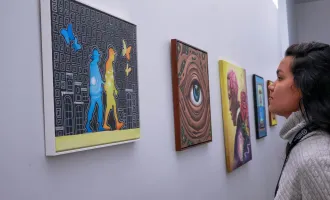
Dior Would Be Proud
Editor's note: This is the final article in Emily Vivian Huang's limited series on the celebrated haute couture designer, Christian Dior.
In 2017, the Musée des Arts Décoratifs in Paris held a grand exhibition named “Christian Dior, Couturier du rêve,” or “Christian Dior, Designer of Dreams,” to honor the House of Dior’s 70th anniversary. Showcasing the couture works of Dior and his successors, it was a huge success, attracting almost a million visitors.
About three years later, the official Christian Dior YouTube channel uploaded an hourlong documentary of the makings of the exhibition. Featuring curator interviews and behind-the-scenes footage, it also provided glimpses of some of the exhibition’s “rooms.”
Though short, these snippets were valuable accompaniments to some of the documentary’s topics, such as the House of Dior’s transition through its successive designers.
The exhibition’s “Designers for Dior” installation may have literally shown how Dior has changed throughout the years. But on a larger scale, the entire exhibition itself is a progression of Dior as well.
Each “room,” or installation has its own thematic element, and shows something unique about Dior from the other — whether it is a display of couture pieces, archival photographs, or accessories.
It progresses all the way through a story, building up the anticipation with each successive room, before resolving with a sense of fulfillment.
The end of the video takes us through some of the rooms, and it is apparent that no two are exactly the same.
Just like how the House has progressed in new ways under each designer, each room adds something new to the story.
There is the “Designers for Dior” installation, of course, but there is also “The Dior Gardens” to showcase the key floral pieces. Nearby is the “Les Ateliers,” which honors the Dior tailors for their immense skill and contribution.
Elsewhere, a wall of high fashion magazine covers pay tribute to the press that has shaped Dior over the years.
The creativity and variety of the themes are virtually endless.
There is even a small section termed “Diorama” (pun intended), which shows a “cabinet of curiosities” of just about everything Dior — Dior pieces recreated onto miniature doll mannequins; shoes, perfume bottles, handbags, cosmetics, pieces of artwork, and more.
To add to the aesthetic perfection, they are all arranged chromatically through a color spectrum, which also includes black and white.
It is truly another way to appreciate Dior as a whole, and to realize that as a couture house, Dior creates more than just clothes.
Rather, it creates an entire image through its accessories as well — the image of the Dior Woman.
And last, but certainly not least, there is the “Hall of Mirrors”— arguably the most stunning installation, in which a display of Dior evening gowns sparkle under the Musée’s arched nave ceiling.
Among them include Venus, Junon, and gowns worn by famous actresses and royals, the designs breathtaking and the colors romantic.
Illuminated by a light show that projects stars across the arches, the nave looks like an enchanted ballroom full of well-dressed guests.
It is really a sight to see, and probably what many visitors found the most stunning in the entire exhibition.
“When I work on a large exhibition like this, I really feel like I’m working on a film set,” said curator Florence Müller in the documentary.
“It’s just like that! All the different professions needed to contribute to this joint task is truly mind-boggling. Everyone has to work in the same way, like on a film, and we work in sequences.
“[This means] we step back and consider whether we need darker tones, lighter tones, calmer, more subdued rooms, or something stronger, all of a sudden. It’s a progression until the end, and the end is like a final act.”
In this way, “Christian Dior, Designer of Dreams” is not just a regular exhibition. Rather, it is like a play — a very eye-catching, visually appealing play, in which the characters stand still and let the story do the talking.
But like any other museum showing, it couldn’t have happened without all the dedication, cooperation, and teamwork that went into creating it. So many people were involved in making this dream a reality.
The curators and organizers who oversaw the pieces, deciding how exactly to use each room’s architecture to tell the story.
The audiovisual designers who created custom lighting effects, breathing life into the garments and the Musée itself.
The artists who painstakingly crafted each paper flower for the “Dior Gardens,” the staff who lifted and arranged each toile in the “Les Ateliers.”
The textile conservators working away in the lab, the conservators in other museums like the De Young, carefully preparing the Musée’s requested loan pieces for travel. The list goes on and on.
But it is more than worth it. Even if we cannot see every single person who played a part in creating this world, the effort is apparent.
The attention to detail shows. And it is probably not even over yet — considering its huge success in Paris, London, and now Shanghai — I would not be surprised if they soon announced another location to try, and a fresh audience to amaze.
Because just like how Dior is timeless, it is also boundless, bringing people from all over the world together through one love for a couture icon and his legacy.
There is no doubt about it. If he could see all of this, Christian Dior would be proud.
Today, there are over 200 Christian Dior stores across the world, each continuing to perpetuate the House’s impact across borders.
The name is iconic, respected deeply by everyone in the fashion world, and known even by those unfamiliar with couture.
Having cemented its place, Dior will continue to uphold its impact far into the future, adapting its values to the changing times. That much is apparent.
But 73 years ago, at 30 Avenue Montaigne, a man named Christian Dior showed his first couture collection under his own name and made history.
In a time of desperation and struggle from the war, he showed that there was a new horizon — a “New Look”— ahead of them.
The war and its restrictions were painful, but they wouldn’t last forever. People could dress up and look beautiful again.
People could be happy again. There was a light on the other side, and there was a future to look forward to. A future worth waiting for, even if it seemed impossible.
Thank you, Musée des Arts Décoratifs, for putting together such a world in Dior’s honor. And thank you, Monsieur Dior, for reminding us — even years later — that there can still be beauty in a world like this, and that hopefully, a new day will come for all of us.



